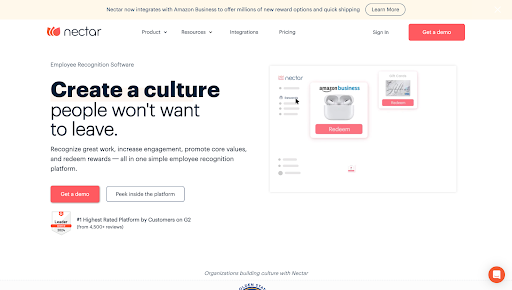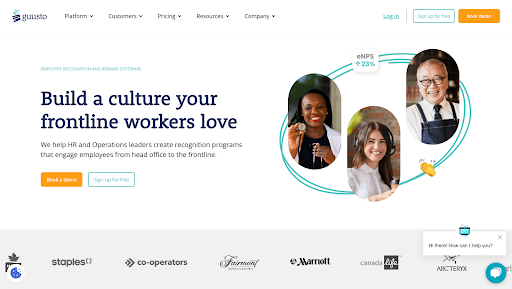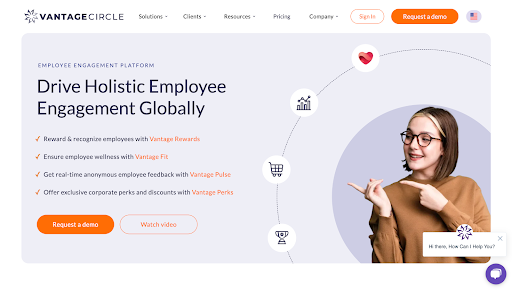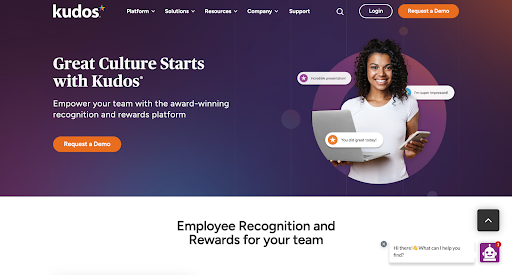Employee recognition software: A guide for HR professionals looking to motivate staff
The 2023 Employee Success Trends report by Quantum Workplace finds that lack of appreciation is one of the leading causes of employees quitting. Yet, only around half of employees report having recognition programs at their company, according to further research by NectarHR.
If you don’t make employee recognition a priority, your team could become demotivated, leading to increased turnover. When building a strong company culture that inspires loyalty and increases motivation, employee recognition isn’t a nice-to-have – it’s a must.
But don’t worry, there’s HR technology for this – employee recognition software.
Employee recognition software enables you to recognize and appreciate your people and their skills without exhausting your HR team’s time and effort.
In this article, we dive into the importance of employee recognition platforms, cover some of the top software out there, and outline our best practices for implementing them in your company to uplift your employees.
Table of contents
- What is employee recognition software?
- Why are employee recognition platforms important to HR professionals?
- 5 best employee recognition software
- 3 best practices for leveraging employee recognition software in your HR department
- 3 examples of companies succeeding with employee recognition software
- Use employee recognition software to retain and motivate rockstar team members
- Employee recognition software FAQs
What is employee recognition software?
Employee recognition software (ERS) is a tech solution that helps HR professionals strengthen their company culture by celebrating their team’s contributions and successes. With it, you can track the performance of your employees and share public or private appreciation or rewards.
Employee recognition software can be used to spotlight employees for their great work on a project, work anniversaries, service awards, and birthdays, or even just for being a stellar team member who’s always willing to lend a helping hand.
To break it down into more concrete terms, employee recognition software enables you to:
Send messages of appreciation to employees
Send monetary rewards, such as gift cards
Share employee wins publicly on a social wall
Create different types of recognition programs for different departments or seniority levels
Gamify the process to encourage peer-to-peer recognition
Manage incentive programs
While employee recognition software can be used to help manage your employee incentive programs, they’re not exactly the same thing.
An employee incentive program is a formalized process that an employer uses to award incentives to its employees. Employee recognition software focuses less on incentivizing employees to work hard and instead centers on recognizing them for the things they’ve already accomplished.
Why are employee recognition platforms important to HR professionals?
Employee recognition programs show your employees that they’re valued and that their contributions aren’t going unnoticed.
Since employees tend to be happier in companies where their hard work is recognized, implementing employee recognition software can help boost your team’s motivation and engagement levels.
In fact, 77.9% of employees say they would be more productive if they were recognized more frequently.
But it’s not just about productivity. Employee recognition can also be a great strategy for improving employee retention.
The problem? Recognition programs are difficult to manage without the right tech.
A one-size-fits-all approach doesn’t work with recognition programs because not all employees are motivated by the same things.
Employee recognition software removes a lot of the legwork by tracking what’s working in your recognition program, how employees are responding, and its overall effectiveness.
It gives you a better understanding of the type of recognition and rewards your people enjoy receiving so you can refine your program and increase its effectiveness.
Employee recognition platforms are an especially important part of remote working technology, as it can be difficult to recognize remote or hybrid employees in a way that’s meaningful in a virtual work environment.
Companies can use this software to better connect with off-site employees in an impactful way. When you increase connection, you build an inclusive culture that extends outside of the office to your employees across the globe. Recommended reading: TestGorilla’s guide to employee recognition statistics
The best insights on HR and recruitment, delivered to your inbox.
Biweekly updates. No spam. Unsubscribe any time.
5 best employee recognition software
Not all employee recognition software may be right for your company’s needs. Some are better for remote recognition, while others are built for frontline workforces.
We’ve gathered some of the top employee recognition software to help you decide which one makes the most sense for your HR tech stack.
Factors we considered
Ease of use: The platform should be easy to navigate, have a smooth navigation workflow, and include a mobile app; providers should also offer solid customer support
Customization: The platform should enable admins to personalize eligibility rules, rewards catalogs, incentive types, custom rewards, leaderboards, and points/badges
Integrations: The platform should integrate with performance management systems, feedback platforms, HRIS systems, or communication channels like Slack and Microsoft Teams
Data and analytics: Beyond just providing a reward system, the platform should provide real-time insights into program performance, employee engagement, and return on investment
The top employee recognition tools: A summary
Software | Summary |
1. Nectar | - All-in-one recognition platform: recognition, rewards, milestones - Challenges for incentivizing participation in wellness initiatives - Extensive rewards selection |
2. Bonusly | - Point-based peer-to-peer recognition - Create and manage incentive programs - In-depth analytics dashboard to discover top recognition themes |
3. Guusto | - Gift-based ERS for frontline workforces - Offline recognition feature for tech-averse employees - Assistance developing initial pilot program |
4. Vantage Circle | - Employee recognition platform for global workforces - Extensive global rewards catalog available in 70+ countries - All-in-one product suite for HR teams |
5. Kudos | - ERS focused on building a strong culture through recognition - People Analytics provide deep insights into program -Pulse surveys to collect information about your culture |
1. Nectar: Best for improving employee retention
Nectar is an all-in-one employee recognition software for managing recognition, rewards, and celebrating employee milestones.
With Nectar points, you can incentivize employees to participate in your recognition program, and those points can then be redeemed on their Amazon reward gateway or for company swag.
Nectar also provides a challenges feature that can be used to encourage employees to participate in activities like employee wellbeing initiatives. All you have to do is create a challenge, and employees can self-report upon completion. You can even require an explanation or photo proof in order to redeem their reward.
Pros
Intuitive interface
Extensive rewards selection
Robust analytics and reporting capabilities
Integrates with the most popular HRIS systems/HCM systems
Well-suited for medium and small businesses
Cons
Pricier than other platforms
Rewards are expensive – employees may need to save points for a long time
Rating: 4.7 out of 5 (G2)
Pricing at time of writing: From $2.75 per user per month
2. Bonusly: Best for building a high-performing culture
Bonusly is an employee recognition platform that’s focused primarily on peer-to-peer recognition.
At the beginning of the month, each employee receives an allocation of points, which they can then use to recognize their peers. This helps take the onus of recognition off managers alone.
Bonusly also provides a wealth of real-time HR analytics that you can use to analyze and improve your recognition program. In the analytics dashboard, you can find metrics such as which team members are recognized most, how your team participates, or top recognition themes.
Pros
The platform is easy to navigate
Ability to create incentive programs
Can include GIFs in employee shout-outs
Free trial available
Cons
Social feed makes awards visible to everyone company-wide
Users have reported software functionality glitches
Rating: 4.8 out of 5 (G2)
Pricing at time of writing: From $3.00 per user per month
3. Guusto: Best for companies with frontline employees
Guusto is a gift-based employee recognition software built to impact frontline retention in healthcare, retail, hospitality, and similar industries.
One problem with ERS platforms is that many require employees to participate using their company email addresses. But employees working in the field (hospitals, for example), may not actually have a company email. In these instances, Guusto offers an offline recognition feature that routes employee rewards to the manager to hand-deliver.
In addition, Guusto’s team works with you to develop a pilot program to test out before rolling it out to your entire organization to ensure functionality and effectiveness.
Pros
Free forever plan available
Employees can pass on gifts to someone else
Helps you custom build pilot programs
Cons
The platform can be slow
Not as many merchant options as other competitors
Rating: 4.9 out of 5 (G2)
Pricing at time of writing: $0 to $400/month
4. Vantage Circle: Best for engaging employees globally
Vantage Circle is an engagement platform built primarily for global corporations. Its global rewards platform is available in more than 70 countries, so you don’t have to worry about anyone on your team being left out.
Vantage Circle is an all-in-one product suite for HR teams that includes a gamified employee wellness platform, employee feedback platform, corporate discounts platform, and more.
It even has onboarding software to foster a sense of belonging and culture on the first day a new hire starts. When you make employees feel welcome, they are more likely to participate in your recognition program.
Pros
Comprehensive solution for many HR needs
A large variety of merchants
User-friendly interface
Cons
A time lag between receiving and redeeming coupons
No option to hide recognition activity
Rating: 4.7 out of 5 (G2)
Pricing at time of writing: From $2.69 per user per month
5. Kudos: Best for gamifying peer recognition
Kudos is an award-winning employee recognition platform that’s focused on building good company culture through peer recognition. Employees can share public messages of recognition to spotlight their peers or nominate each other for awards.
Its People Analytics feature provides deep insights into employee performance, employee experience, and overall workplace culture.
In addition to recognition, you can use it to improve your company’s culture by sending out pulse surveys. In these surveys, you can gather information about how employees are feeling about their supervisors, the company as a whole, and engagement and productivity levels.
Pros
Flexible options for providing recognition
Very user friendly
The company offers additional HR solutions
Cons
Pricing not publicly available
Unused kudos don’t roll over each month
High visibility could deter introverted employees
Rating: 4.8 out of 5 (G2)
Pricing at time of writing: Starts at $3.25 per user per month
3 best practices for leveraging employee recognition software in your HR department
Simply having employee recognition software isn’t enough. To motivate your employees, you need an effective recognition program.
Here are some actionable practices for maximizing the effectiveness of employee recognition software to boost motivation and retention.
Strategies for using an employee recognition software: A summary
Best practice | Summary |
1. Use employee surveys to ask your people what they want | Minimize time and money wasted by figuring out whether your employees prefer public or private recognition and the type of reward program they find most valuable |
2. Use insights to monitor and continuously improve and customize your program | Personalize your recognition programs to your processes and company culture and use insights from your employee recognition software to improve them continuously |
3. Encourage peer-to-peer recognition | Offer incentives and make the act of sharing feedback easy to make recognition an intrinsic part of your company culture |
1. Use employee surveys to ask your people what they want
To build an employee recognition program that’s truly effective, you need to listen to your people.
If you offer recognition in a form that your employees don’t care about, you’re just wasting your HR team’s valuable time. And if you’re giving out rewards that nobody wants, you’re throwing money away, too.
The bottom line is that not every workforce wants the same type of recognition, and while most employees want recognition, not every employee wants public recognition.
Introverted employees, for example, might feel anxiety or even a sense of embarrassment from being publicly recognized. This is one instance where private recognition may be more appropriate.
Don’t assume that you know what your employees want. Instead, survey your people to see what types of reward options they find most valuable.
You might choose to send out an employee pulse survey every month or quarter to keep up with any changes.
Additionally, you can use a poll to segment your employees into those who prefer public recognition, those who prefer private recognition, or those who would appreciate either, to ensure your recognition is properly tailored to individual team members.
2. Use insights to monitor and continuously improve and customize your program
Employee recognition software isn’t a “set it and forget it” kind of deal.
Your software should enable you to personalize your recognition programs so they’re baked into your processes, aligned with your company culture, and take into account the needs of your team.
Just 13% of employees with a recognition program at their company rate it as excellent.
If you want to truly impress your people, you need to continuously monitor the success of your program. Along with asking your team to rate the effectiveness of your program, you should also consider things like:
Has employee turnover decreased?
Do you notice an increase in overall morale?
Has employee productivity increased?
As your workforce grows and people inevitably cycle in and out of roles, the needs of your program may shift.
It’s a good idea to collect these metrics in an HR dashboard, where you can then regularly analyze them to tweak and improve your program as needed.
3. Encourage peer-to-peer recognition
Many employee recognition platforms offer peer-to-peer recognition features. Harnessing these features helps you build a culture of recognition where employees naturally celebrate everyone’s achievements.
Peer-to-peer recognition involves employees recognizing each other’s work and accomplishments.
While supervisor feedback is critical for employee growth, receiving employee feedback directly from the team members they work closely with on a day-to-day basis can be even more powerful.
Employees who receive praise from their peers or social recognition are more likely to try their best and go the extra mile. It’s been shown that peer feedback can improve employee performance by up to 14%.
To encourage employees to participate, make sharing feedback as easy as possible. For example, you might create a private form and ask employees to share the name of a colleague and a comment about them that your HR can share with the rest of the team later. You may also consider offering incentives for these nominations.
When giving recognition is no longer a task that employees have to go out of their way to do, recognizing each other’s achievements becomes an intrinsic part of your company’s core values.
3 examples of companies succeeding with employee recognition software
Let’s take a look at three impactful examples of companies that implemented employee recognition software to engage and retain their employees:
Toast
Compass One Healthcare
Rechat
1. Toast
Toast is a cloud-based restaurant management software that transitioned to a distributed workforce in the early days of the COVID-19 pandemic.
With teams spread out across the globe, many of its employees started feeling a disconnect. They missed in-office perks like impromptu chats and opportunities to engage with other departments.
The company invested in Bonusly to create “virtual high five” opportunities for its employees. In the first 12 months after implementation, Toast employees had recognized each other more than 27,000 times.
As a side benefit, using Bonusly alerted Toast to a concerning reality: The team members who were receiving the most recognition were often burnt out due to an extremely high workload.
Observing this trend enabled the HR team to take steps to distribute work more evenly and mitigate burnout.
2. Compass One Healthcare
Compass One Healthcare is an organization with more than 68,000 frontline employees in hospitals, senior living communities, and other facilities.
During the COVID-19 pandemic, the company found its employees working long hours to serve people in need, putting them at serious risk of burnout. To combat this, the HR team at Compass One implemented Guusto and created three tiers of what it calls GEM awards:
GEM Frontline: Awards for employees who best reflect the program’s mandate
GEM Spot: Awards for employees who demonstrate company values
Gem Milestones: Awards for years of service
By creating multiple award tiers and using employee recognition software built specifically for frontline workforces, the company was able to increase its retention rate.
Compass One discovered that its GEM award winners were twice as likely to stay with the company as non-winners. This impact on retention was so clear that other parts of Compass Group are now beginning to buy into the program.
3. Rechat
Rechat is an AI-powered real estate software for agents and brokers.
As a fully remote team, it wanted a way to celebrate its positive work culture and help its team members thrive no matter the location.
However, with limited HR resources due to being a small team, the company needed to figure out how to keep administrative time to a minimum – which is where employee recognition software came in.
Since 2023, the company has been using Bonusly to capture everyone’s contributions within its remote workforce.
Not only does its recognition program have an average participation rate of 94%, but it’s also provided an additional benefit. Through its automation and integration capabilities, using employee recognition software greatly improved the HR process at Rechat as a whole.
Use employee recognition software to retain and motivate rockstar team members
Employees who receive recognition on the regular are more motivated and engaged at work and less likely to burn out.
Employee recognition software is a powerful tool for HR professionals who need to manage recognition programs for large teams, both in-person and remotely.
It’s just one of many tools in the HR automation toolset that can help you retain your best employees while also lifting some of the heavy lifting off of your human resources department.
Not sure where to begin?
You could start by recognizing your employees for their growth using talent assessments, such as the Computer Literacy (PC) test.
TestGorilla offers a wide library of 400+ talent assessments, so schedule a live demo with our specialists, or get started with our free forever plan today!
Employee recognition software FAQs
Have more questions about implementing employee recognition software in your HR department? Check out some of the FAQs below.
Does employee recognition software work?
Employee recognition software gives your employees a voice, celebrates their key milestones, and praises top performers, helping to foster a positive company culture. This naturally leads to increased employee engagement and a decrease in turnover.
That said, as with HR technology trends, you get out of your ERS what you put into it. Employee recognition software requires continuous monitoring and refining – if you expect it to do all the heavy lifting, it won’t be as effective.
How do you get company buy-in for employee recognition software?
To get company buy-in for employee recognition software (like Motivosity and Blueboard), it’s important to focus the conversation on how recognition plays into the company’s overarching goals. For instance, employees have been proven to be more productive when recognized, and productive employees produce better work – ultimately increasing the bottom line.
Additionally, illustrate how much time and effort it can take to manage recognition programs manually. Then, position employee recognition software as a valuable hybrid working technology to conserve resources in your HR department.
Is there free employee recognition software?
Many of the best employee recognition platforms have a free plan or at least offer a free trial – including Nectar, Guusto, Bucketlist, Workday, and Bonusly. However, many of their top features are often available only on paid subscriptions. If you want your employee recognition program to be as effective as it can be, it’s usually worth investing in paid software.
How much do employee recognition platforms cost?
In general, expect to spend an average of $5 to $20/month per employee for employee recognition software or $60 to $240 per employee if you’re paying annually. However, know that the total cost of the software greatly depends on the size of your company and your exact needs.
Another good rule of thumb when it comes to employee recognition investment (including values-based rewards) is 1% or more of payroll.
You've scrolled this far
Why not try TestGorilla for free, and see what happens when you put skills first.



















